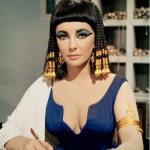 She is a timeless icon of femininity and feminism. She is the most famous woman in the history of the world–perhaps because she was, and remains, the most powerful woman in the history of the world. No subsequent queen or prime minister or secretary of state has ever had the geographic dominion, relative wealth, and unfettered authority that was enjoyed by Cleopatra VII of Egypt.
She is a timeless icon of femininity and feminism. She is the most famous woman in the history of the world–perhaps because she was, and remains, the most powerful woman in the history of the world. No subsequent queen or prime minister or secretary of state has ever had the geographic dominion, relative wealth, and unfettered authority that was enjoyed by Cleopatra VII of Egypt.
Almost everything we know about her has been filtered through the propaganda of her enemies. What remains are the scant facts and what we can deduce from them. She was a woman of extraordinary charm who shared a bed with not one, but two of the most powerful men in the ancient world–Julius Caesar and Marcus Antonius. She would become mortal enemies with a third–Octavian, otherwise known as Augustus Caesar–who did more to immortalize her than her lovers.
But she comes down to us through the ages without a face. Her coins–many of which depict her in quite severe and haggish ways–are stylized portraits, meant to impart terror rather than admiration. The few busts that we believe portray the Egyptian queen cannot be verified. There are no extant portraits nor textual descriptions of her. Because of this, artists have a blank canvass upon which they can imagine this cunning political queen in any way they like. That is a siren’s call to Hollywood who has made several attempts at bringing Cleopatra to life.
First, there was the silent film starring Theda Bara which was destroyed because it was too racy!
In 1934, Claudette Colbert starred in a Cecil B. DeMille production about the Queen of the Nile. The production is old-fashioned, in black and white, but the dialog is often fun. This is an Egyptianized version of the queen, which is not necessarily entirely inaccurate, but there is little visual reference to her cultural heritage as a Hellene. I especially like the invention of Herod making trouble between Cleopatra and Antony–which is unlikely to have happened the way it plays out on screen, but hints at the genuine trouble between the two client monarchs! There’s a certain jaded maturity that Claudette Colbert brings to the role, but the entire picture seems too small to incorporate such a big historical figure.
This is not to say that the film is all eye-candy and soap-opera. The costuming and set-decor is an interesting mix of Egyptian, Roman and Greek–all of this in keeping with accounts we have of Alexandria where cultural fusion was the norm. Though the film never mentions Cleopatra’s children by Antony–including the heroine of my own debut novel, Cleopatra Selene–it’s fairly historically accurate; viewers will learn from this film as well as be entertained. Not much better can be said for Hollywood than that!
Perhaps with an eye to how difficult it would be to top the 1963 Elizabeth Taylor version, Cleopatra has appeared primarily on the small screen ever since. The 1999 Television Mini-Series starring Billy Zane, Timothy Dalton and Leonor Varela was based on Margaret George’s excellent novel, Memoirs of Cleopatra. Unfortunately, the series bears little resemblance to the book. In this version, Cleopatra is a foot-stomping, whining, little brat who never brings any gravitas to the screen. Alexandria is rendered similarly unimpressive. While Varela’s looks may be more in line with the historical Cleopatra–her profile looks like the coins–her acting is fairly atrocious. It’s actually Billy Zane’s boyish rendition of Marcus Antonius that is the most convincing.
Which brings us to the latest incarnation of Cleopatra, Lyndsey Marshal’s version on HBO’s Rome. While I can find nothing bad to say about the series as a whole, which was masterfully written, funny, absorbing and dramatic–our Egyptian queen got the short end of the stick. Here she’s portrayed as a drug-addled slut who deceives Caesar about the parentage of her son. There’s nothing in the historical record to suggest this, other than Augustus’ accusations against her, but not every portrayal can resuscitate the queen’s image. Marshal brings a little bit of cunning to the role and never lets us forget that Cleopatra is without moral scruple–in that, she may be the closest portrayal to the historical woman.
It’s impossible to tire of Cleopatra and Hollywood seems poised to make another attempt. Given the run-away success of Stacy Schiff’s recent biography, a new movie is being planned starring Angelina Jolie. Reportedly, this film will focus more on Cleopatra as a mother and strategist. It remains to be seen what sort of images will leave their mark in popular culture this time!